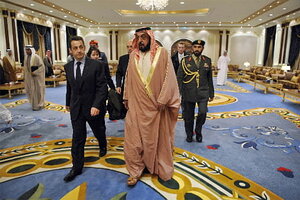Why Arab presidents and princes are pledging millions to Philippines in typhoon Haiyan aid
Middle Eastern countries employ an estimated 2 million Filipino migrant workers, often illegally, giving them a strong if sometimes problematic connection to the Philippines.

United Arab Emirates' President Khalifa bin Zayed Al Nahyan, seen here with French President Nicolas Sarkozy in 2008, has promised to organize assistance programs worth 37 million dirhams ($10 million) to help the Philippines recover from Typhoon Haiyan, Arab News has reported. Other nations, including the US, have also pledged aid.
Erik Feferberg/AP/Pool/File
Jerusalem
As representatives of the 700,000 Filipinos living in the United Arab Emirates prepared for a typhoon fundraising brunch this weekend, the UAE president promised to organize assistance programs worth 37 million dirhams ($10 million) to help the Philippines recover from typhoon Haiyan, Arab News has reported.
“It’s so heart-warming to know that other nationalities are also willing to help our compatriots back home,” said Matilyn Bagunu, the president of Filcom, which represents Filipino community groups in Dubai and the Northern Emirates.
Meanwhile, Saudi Prince Talal bin Abdul Aziz pledged $100,000 on behalf of the regional Arab Gulf Program for Development (AGFUND), and the Israeli government as well as the Israeli humanitarian organization IsraAID have sent preliminary teams to help with medical care and search and rescue missions.
With an estimated 2 million Filipinos living in the Middle East, these countries all have a very human link to the Philippines. But it is also a problematic one, since some Filipino migrant workers arrive illegally or stay on after their visas have expired, risking deportation of themselves and/or their children.
And even those with the proper documentation have – together with other migrant workers from Southeast Asia – faced inhumane conditions in the Gulf countries, including working in scorching temperatures without adequate water; living in unsanitary conditions; and being denied access to their passports by employers who force them to work extremely long days, sometimes without pay or days off. And they often enjoy very little legal protection, as illustrated by the execution of a 17-year-old Sri Lankan maid in Saudi Arabia last year, which sparked widespread criticism not only from human rights organizations but Saudis themselves.
Saudi Arabia is currently rounding up illegal workers, after an amnesty recently expired. So even as Prince Talal was pledging $100,000, hundreds of Filipino workers were being brought to a deportation center. And Israel, which for years had a relatively liberal policy of allowing family members to accompany migrant workers, also has been strongly criticized for a 2009 decision to deport immigrant children who do not meet strict criteria, inspiring the Filipino film “Transit” that came out this year.
While many migrant workers have lived in the region for years, and raised funds for previous disasters, typhoon Haiyan is on a far bigger scale.
Even for those whose families are safe, the destruction of their homes represents years of hard-earned remittances washed away in a moment. Though Filipino migrant workers’ remittances account for nearly 10 percent of the national GDP back home, according to The National newspaper in Abu Dhabi, they have little influence over political decisions – such as how much to invest in disaster preparedness.
But Filipino ambassador to the UAE Grace Princesa says she plans to launch a disaster management education program for Filipinos in the Emirates. That way, she suggests, they will be able to send back not only remittances but also knowledge that could help save their families from future disasters.

